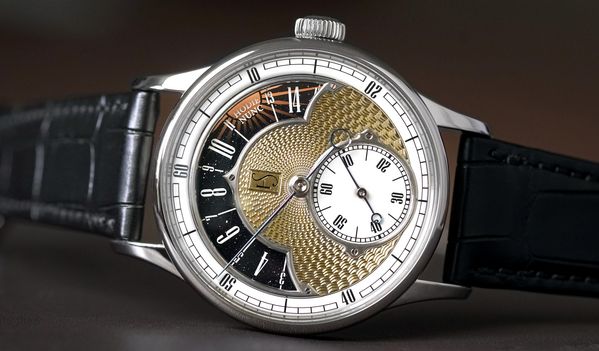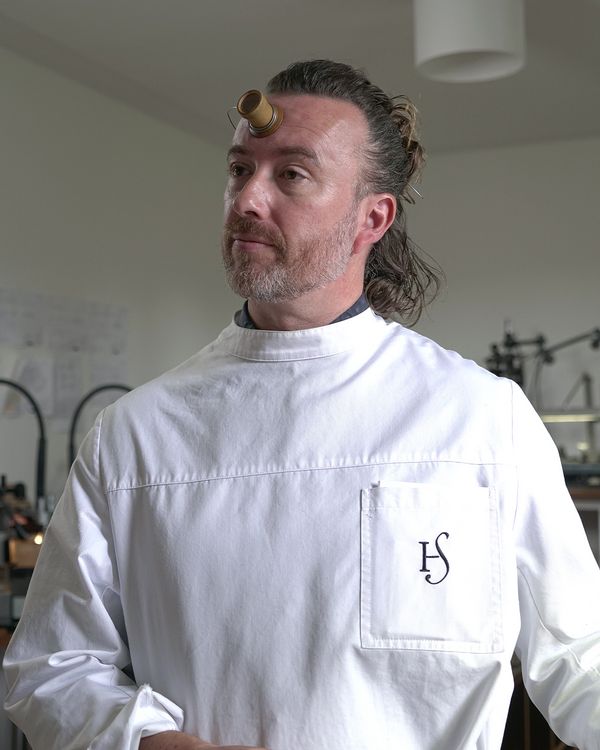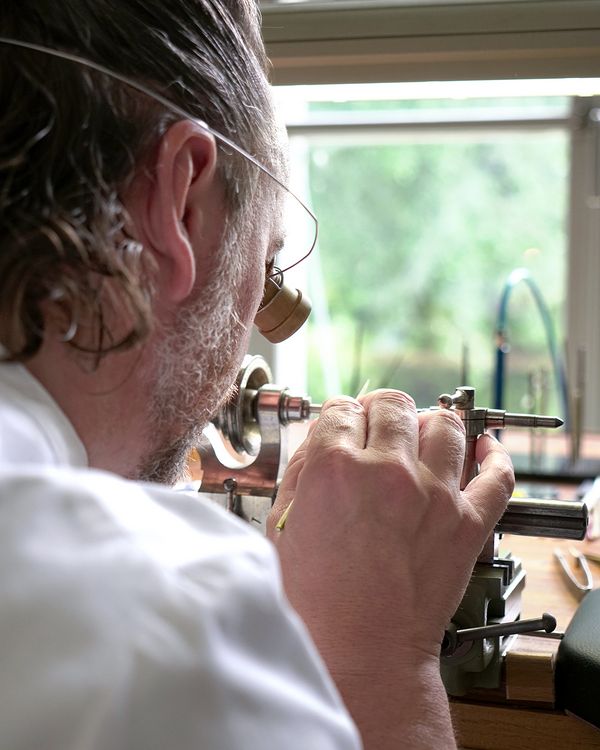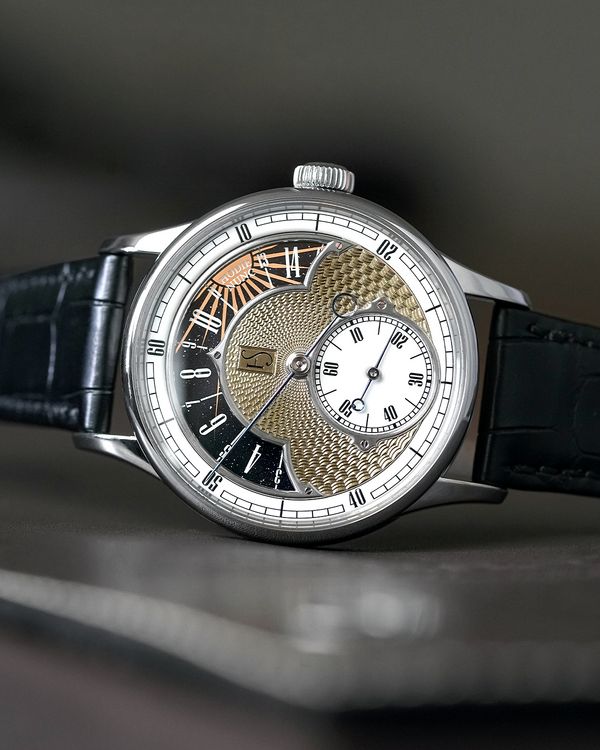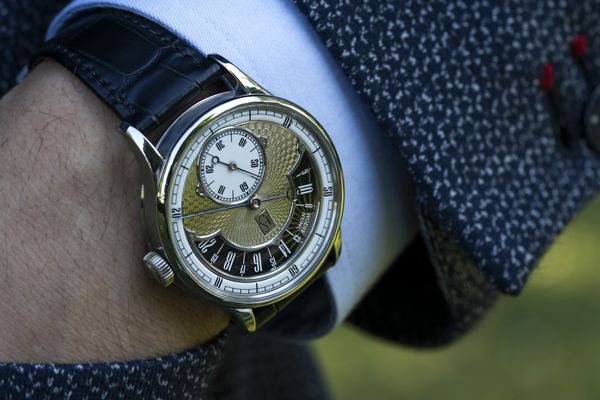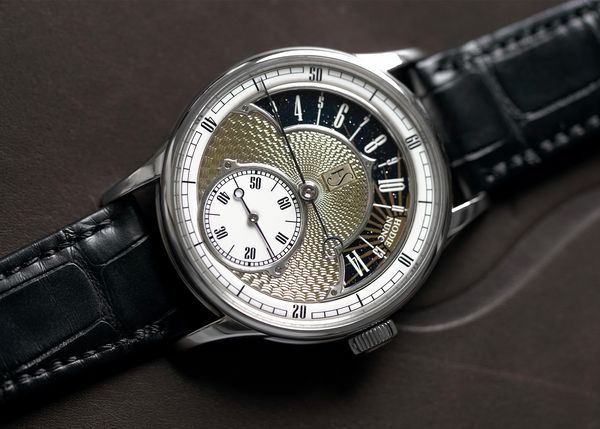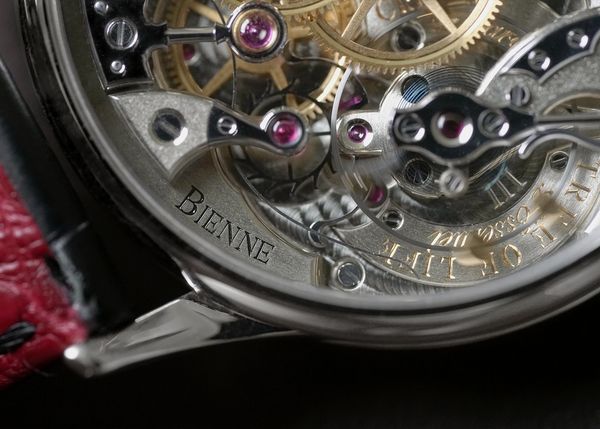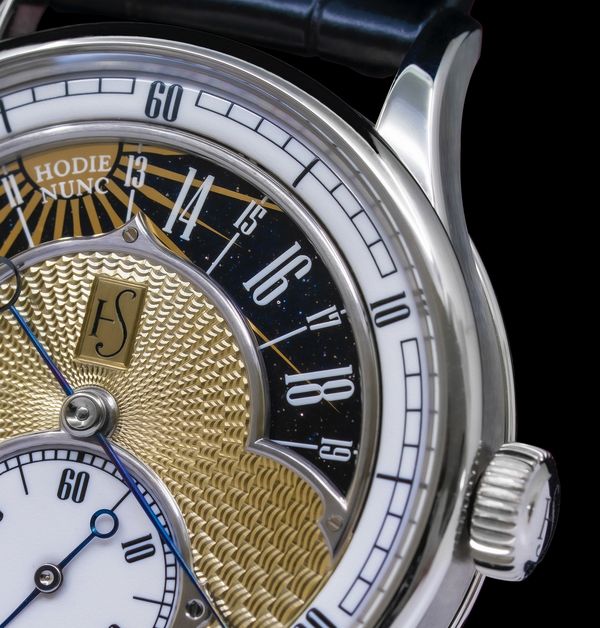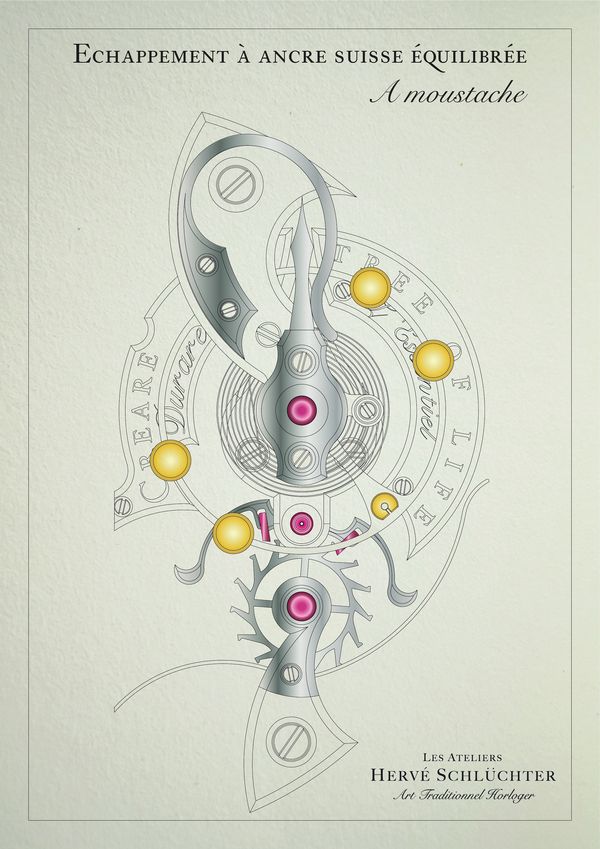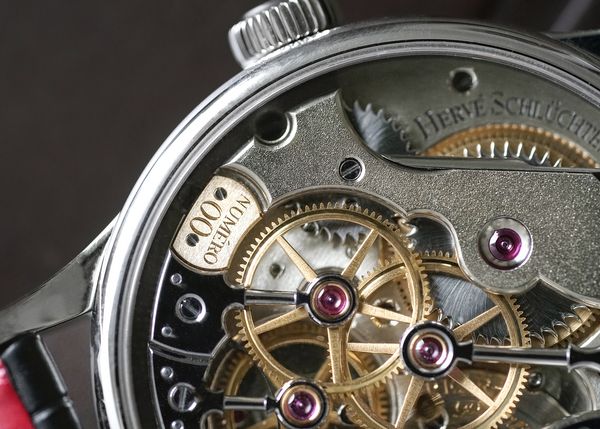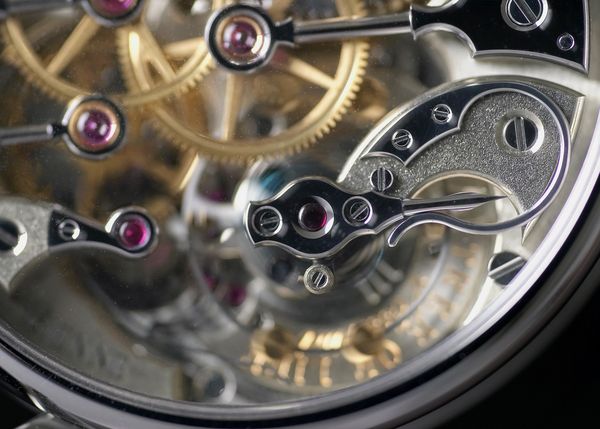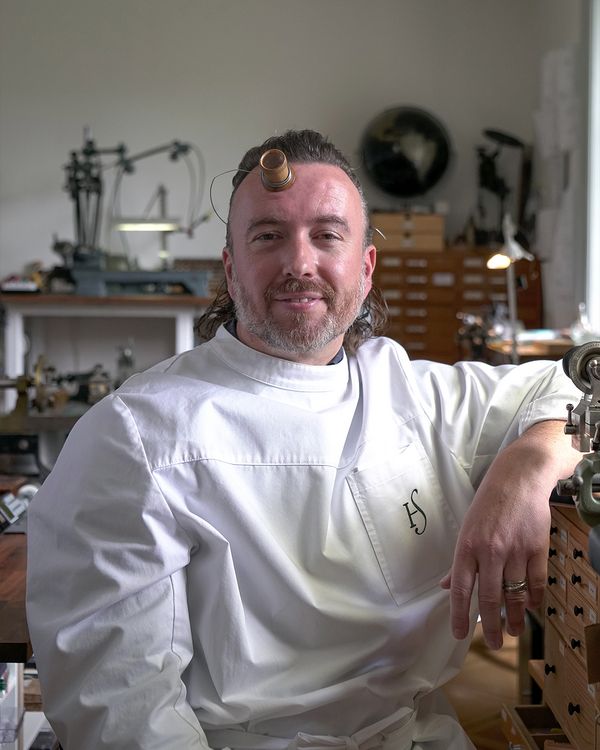The Indie Insider is our column dedicated to exploring the vast world of independent watchmaking through the eyes of Phillips in Association with Bacs & Russo. Expect in-depth coverage of the latest and greatest watchmakers and releases to enter the scene, as well as detailed analysis on all your favorite familiar names.
– By Arthur Touchot; images by author unless noted
Twenty-sixteen was the year that changed Hervé Schlüchter's life.
Two months after unexpectedly losing his father, the Swiss watchmaker would experience the joy of becoming one, following the birth of his first child. A son.
Those two events and their proximity were "a shock to the system," he says, forcing Schlüchter to take a step back and reevaluate his goals and priorities in life.
Professionally, things had been going great.
Schlüchter managed Dimier 1738, a manufacturing facility purchased in 2006 by Bovet. He felt at home there, having joined the team in his mid-20s before rising through the ranks and eventually landing his dream job by 32.
But in 2016, those achievements suddenly became trivial, as Hervé realized he hadn’t fulfilled the dream that had pushed him, as a teenager, to become a watchmaker.
Indeed, shortly before passing away, Hervé's father had asked him to build a pocket watch, like the one Hervé’s grandfather used to wear every time he left the house.
Schlüchter never got the chance to start the project, but he knew the kind of work that watch required. He had met and admired artisanal watchmakers throughout his career and had seen how they built watches independently, using traditional tools and finishing them by hand in their atelier, over several months.
He remembers when, in 1996, he picked up a watch magazine that presented Philippe Dufour’s Duality, a watch that symbolized the return of traditional watchmaking to the Vallée de Joux.
The watch's original movement architecture had struck the 18-year-old student. "It wasn't commonplace to see a watch with two balance wheels," Schlüchter remembers.
That day, he returned home and started sketching watches that might one day bear the Schlüchter name. Unfortunately, Hervé never found the time to work on his own project, and he was sadly caught short by his father's request.
Life's twists and turns had led him on a different course.
Schlüchter’s Story
Herve grew up in Le Bémont, a small suburban satellite of Saignelégier, Switzerland.
Seen from above, the town looks identical to the many that dot the border between Switzerland and France, except for one large building, responsible for shaping Hervé’s youth – an indoor sports resort with an ice rink.
Schlüchter spent much of his childhood in that building, playing hockey with his friends. His mother was a familiar figure there. She managed the refreshment bar and kept an eye on the local kids.
Hervé’s father was also an indispensable figure in the community. He presided over the local post office. Some mornings, on his way to school, Schlüchter would assist his father with his mail deliveries. He remembers the brief but significant exchanges they would have with the residents of Le Bémont, and the rare intimate glimpses they would catch, when people swung open their doors to reveal a slice of their private lives. All except for one person: a dialmaker named Georges Brodbeck, whose farmhouse was guarded by three large Dobermans.
Hervé's childhood unfolded in this idyllic setting.
Parallel to his athletic pursuits, Hervé discovered a fervent interest in watchmaking. A pivotal moment came during an apprenticeship where he was challenged to disassemble and reassemble a watch movement – the manual-wind ETA caliber 6497 — a task that ignited his deep-seated passion for horology.
“I fell in love with the craft on day one," Schlüchter recalls. "As soon as the watch I had on my desk started ticking again."
Noticing their son’s interest, Hervé's parents endorsed his decision to pursue his studies at L’École des Métiers Techniques, in Porrentruy. He fought hard there to balance his technical studies with his intensive sports training – he would later sign up for the local hockey team, HC Ajoie, playing at the professional level for them until 2000.
Under the guidance of his teachers, and his mentor, Laurent Barotte, a revered figure in the art of clock restoration and a 2022 Prix Gaïa laureate, Schlüchter's artistic talents flourished, and after obtaining his diploma, he sought a job in the industry close to his roots.
Less than 50 kilometres from his childhood home, Schlüchter found Montres Valgine.
He joined the company in 1998, just in time to discover an exciting project. Montres Valgine had a storied past and was still family-owned, but what made it special was its daring decision to reposition itself as a maker of high-end black-label complications.
This was some years before the industry’s shift towards in-house movements, and the work there had caught the attention of several entrepreneurial executives, including one Richard Mille.
The Frenchman would come in regularly in his role as the Head of Watchmaking at Mauboussin, a client of Montres Valgine, but he was already discussing building his own extremely avant-garde watch brand.
“You can imagine what it was like for us, at the time, hearing him talk about using materials from the aerospace industry,” Schlüchter says. “It seemed completely crazy.”
Mille made his partnership with Montres Valgine official in 2001, when, together with the company’s director, Dominique Guenat, he founded his eponymous brand. However, Schlüchter had already departed Montres Valgine by the end of 2000 in order to join a project that was diametrically opposed to Richard Mille’s.
He joined Progress Watch (later known as Swiss Time Technology), relocating to Biel/Bienne in order to work on the development of affordable tourbillon movements, produced at scale. However, he was soon working on high-end movements once again, following the company’s takeover and re-branding in 2003.
Because of his experience at Montres Valgine, Schlüchter adapted quickly to the new demands at Swiss Time Technology (STT), and he was soon placed in charge of projects for Bovet, in addition to other smaller independent watchmakers, including Antoine Preziuso and Peter Speake-Marin. When Max Büsser began looking for help for MB&F’s inaugural watch, the HM1, he was quick to involve Hervé on that project.
However, the market’s shift towards in-house movements limited STT’s growth; ultimately, Bovet acquired STT and changed its name once more to Dimier 1738.
Again, Hervé observed as constructors changed the signage above the building for the third time since he had joined, seven years prior.
At Dimier 1738, Hervé slowly transitioned to managing the technical office, overseeing patents, and ensuring the quality and timely delivery of parts.
The leadership qualities that Schlüchter had developed on the ice, and the way he had galvanized his colleagues during successive transitions made him an ideal candidate to lead Bovet's new facility and fulfil the brand’s ambitions of turning it into a vertically integrated movement manufacture.
Hervé’s influence on Bovet’s collection was immediate. The young manager had a hand in creating every major release and unique piece for the brand between 2006 and 2016, including developing Bovet's famous double-sided watches and pushing for a wider range of tourbillon models. In fact, his influence on Bovet's current collection is still evident today.
His new position, however, reduced his hands-on work, prompting him to want to reconnect with traditional craftsmanship.
Going Independent
In the wake of his father's passing in 2016, Schlüchter embarked on a new chapter, leaving Dimier 1738 to establish his own creative label.
Hervé's decision to embrace independence later in life than most gave him a unique perspective. With extensive experience and a comprehensive understanding of the watchmaking process, he bucks the trend of young watchmakers who rush to establish their brands right out of the gate.
His inaugural collaboration came through Alchemists, a creative collective interested in the theoretical healing properties of copper, among other things. Their ambitious project presented a timepiece made from an alloy completely new to the watchmaking industry, cuprum 479, a metal that presents an interesting immunity to oxidation.
For guidance on the project, Hervé suggested the team turn to Philippe Dufour.
Dufour’s expertise in finishing and hand-decorating components significantly influenced the project, but it was the time spent together with the old master that made an even greater impact on Schlüchter.
The two had met shortly after Hervé’s decision to launch his own label, but the Alchemists project brought them closer.
“We got to know each other through that project,” Dufour says. “Hervé would come to my atelier quite often, to ask me questions, to observe my methodology and my technique.”
It wasn’t rare for the newly independent watchmaker to remain in Le Brassus for several days, something that surprised Dufour. Schlüchter presented himself as a detail-oriented individual, someone who wouldn’t let go until they felt they had completely mastered a new task. He reminded Dufour of his younger self.
The potential to go further was immediately apparent to the old master. “He is a very mature person, and an experienced watchmaker,” Dufour says. “Together that gives him a very solid foundation.”
But what made him special was his unique personality.
“He is someone who is so humble, and so open to others,” Dufour says. “The relationship was different. It quickly evolved into something that was beyond professional. He’s like a son.”
The Alchemists’ project was well received but the watch’s unique selling proposition failed to connect with collectors, and ultimately, the watch felt a little derivative of Schlüchter's previous work.
Although this venture did not meet commercial success, it was a pivotal learning experience for Hervé, solidifying his resolve to carve out a distinct legacy in the world of horology, and to spend more time on his own project: Les Ateliers Hervé Schlüchter.
But before fully committing to his future aspirations, Hervé felt there was one more call he should make. He remembered the dial maker from Le Bémont, and he had heard that Brodbeck had also chosen to establish his own practice, after discovering the art of engine-turning.
“I arrived at engine-turning by happenstance, in my fifties," says Brodbeck, who has previously crafted dials for Singer, Metalem, and Natéber (now Hermès). "It was a niche that felt unexplored at the time.”
Although he is completely self-taught, Brodbeck quickly established himself as one of the finest engine-turning craftsmen in the region, turning his former employers into new clients.
Hervé suddenly felt the urge to reach out, to finally get acquainted with this traditional craft, which wasn’t taught at Porrentruy.
“I remembered him – the postman’s son; he presented his project and explained that he wanted to decorate his watch,” Brodbeck says. He happily invited Schlüchter to spend a few months at his new atelier, near Le Bémont, to try his hand on the many machines Brodbeck had collected from all over Europe.
Despite the initial setbacks of his independent adventure, Schlüchter's reputation began to resonate within the collector community, thanks in part to endorsements from his new mentors.
“Philippe Dufour was the first person to mention Hervé to me,” explains a Belgian watch collector who agreed to speak with PHILLIPS anonymously. To protect his privacy, we will call him Leo.
Leo recounts his intrigue upon hearing about Schlüchter's work, leading to a memorable virtual presentation during the COVID-19 pandemic.
“It was all a bit mysterious,” Leo says. “Actually, I have a fond memory of that presentation. It lasted around 20 minutes, and the whole time I kept thinking, 'What is this watch going to look like?' It all sounded so romantic, and poetic, but it seemed abstract, and I couldn’t imagine how it would wear on the wrist.”
Preparatory work for the launch of Les Ateliers Hervé Schlüchter began shortly thereafter, as the watchmaker moved into a historic 19th-century villa in Boujean, a district of Biel/Bienne with a fiercely independent character.
The villa, which was previously the residence of the late forestry magnate Johannes Renfer, stands as a rare emblem of Boujean's affluent industrial heritage.
The establishment of Schlüchter's atelier was a monumental effort. He now describes it as his “first project, within the project.”
Villa Renfer is home to another craftsman – a tailor – with whom he shares the ground floor to meet clients in the beautiful foyer, featuring high ceilings and exposed wooden beams that recall the building's past.
Hervé’s atelier is located on the first floor. There, his team of three have set their benches up against tall, single-glazed windows that overlook the Villa’s garden on one side, and on the other, the narrow river that meanders past the Omega and Swatch manufacturing facilities, all the way down into Lake Biel.
Close to Schlüchter's bench, a special place is reserved for a small heap of Gentian pith wood handpicked during the fall of 2021 by Philippe Dufour himself, just in time for the atelier’s official opening a few months later. The pith wood is more than just a symbol of friendship between the two men – Hervé has slowly been going through the stock of wood, using it to polish the edges of his movements.
“Verifying everything, making all the tools that I needed, building a team around me and training the two watchmakers that accompany me, transmitting my knowledge to them, those are the foundations that we are still putting in place”, Schlüchter says.
Months after their initial virtual introduction, Leo vividly recalls his first in-person encounter with Schlüchter at Villa Renfer.
Before the glass door had even opened, Leo had recognized the watchmaker’s big, white smile. Schlüchter had medium-length hair, which he wore in a ponytail, and a short beard that had only just started to turn white. Leo could immediately tell how busy Hervé had been, based on the stains on his previously impeccably white cloak.
The warmth and enthusiasm Schlüchter exuded that day left a lasting impression. Leo's journey into the realm of artisanal watchmaking is driven by such personal interactions. "The chance to meet the creators behind the watches is what draws me to independent watchmakers," he says.
This level of personal engagement, he notes, is one of the privileges of collecting watches from independents, reminiscent of his experiences with other creators like Simon Brette, Theo Auffret, and Stephen McDonnell.
Repeated visits deepened Leo's admiration for Schlüchter, culminating in a profound respect for his authenticity and craftsmanship, and ultimately, an order of Schlüchter's first official watch: l’Essentiel.
“When he finally showed me the piece I was awestruck," Leo says. "It was love at first sight.”
His First Watch
Navigating the intricate world of watchmaking to carve out a distinctive style is a challenge that Schlüchter embraced with open arms.
"Defining my unique style was a daunting task," Hervé says. The watchmaker estimated spending close to two years behind his bench, inside Villa Renfer, drawing inspiration from the changing seasons outside his window.
“He understands that you shouldn’t try to go too fast,” Dufour says.
This period of introspection and creativity culminated in the unveiling of his first major work: L'Essentiel, the inaugural piece of the what Schlüchter calls his "Tree of Life" project.
At its core, the Essentiel is a simple, time-only watch, made in stainless steel and measuring a moderate 39mm in diameter. It features a regulator-style time display, an eccentric choice, especially in the way he’s executed it, which immediately sets him apart from his contemporaries.
Regulator wristwatches are not very common. Because they are rare, and because they look a little odd, people often mistake regulators as modern designs when, in fact, they are inspired by antique clocks made for observatories and other scientific institutions.
The unusual hand arrangement, where the hours, minutes and seconds are divided into three separate sub-dials, is designed to help watchmakers when setting and regulating other timepieces – hence the name, a "regulator" watch.
This nod to history places Schlüchter in a select group of watchmakers, including giants like Patek Philippe, who have ventured to adapt the regulator concept for modern wristwatch wearers.
In terms of major brands, Patek Philippe is on a rather solitary mission to give collectors an opportunity to experience time in this way. The Geneva watchmaker introduced the ref. 5235 more than 10 years ago, and despite its popularity with a very small group of enthusiasts, the base model has yet to spawn any relatives in Patek's catalogue.
Then there’s the RP1, a high-end regulator wristwatch made by Spanish independent watchmaker Raúl Pagès, and that recently grabbed international headlines for winning the inaugural Louis Vuitton Watch Prize.
Both Patek's ref. 5235 and the RP1 are classically styled, in that they offer a traditional three-handed regulator display, but both also introduce additional features to appeal to modern collectors. The ref. 5235 offers an extra complication with an annual calendar, while the RP1 is time-only but is equipped with a rare detent lever escapement, which is more efficient than a traditional Swiss lever escapement.
L’Essentiel doesn’t offer such innovation. Instead, it focuses on more romantic features.
The most striking difference is Schlüchter's decision to replace the hour hand with a large day-and-night disc that rotates over 24 hours, offering a poetic interpretation of time's passage. This is the first time this design appears in a wristwatch, and few will know the clock that inspired it: A rather obscure Antide Janvier clock, dating back to the early 1800s.
“I have always loved its simplicity,” Hervé muses, reflecting on Janvier's work, which is illustrated in Michel Hayard's 1995 biography on Janvier. Schlüchter discovered the book more than 15 years ago and has been captivated by it ever since. It remains in his library to this day, with a bookmark resting precisely between pages 199 and 200, though by now his thumb would know exactly where to divide the book.
The aventurine glass disc that dominates Schlüchter's watch is not just a technical marvel but a canvas for conveying deep personal values. This expansive component, adorned with a gold-plated sun and a silver-plated moon, is etched with Latin inscriptions that resonate with Hervé's core beliefs. "HODIE NUNC," positioned beneath the Sun, translates to "Today Now," while "AMOR GRATIA," set within the Moon's orbit, means "Love Gratitude."
These phrases are reminders of what’s important to Schlüchter, and what he hopes to impart to his children. Clients are given the option to personalize these inscriptions, however, some clients believe doing so would distort the watchmaker’s original motivations.
“I wanted to customize it,” Leo says. “But I chose to go back to the original design because that’s the one I fell in love with. I thought the artist’s logic was very clear in the way the watch was conceived.”
Besides the aventurine disc, the watch features many classical elements that distinguish it from any of Schlüchter's past work, and that reveal his distinct experiences with Georges Brodbeck, Philippe Dufour, and other influential independent watchmakers.
At the centre of L'Essentiel is its main dial, made in maillechort – a harmonious blend of nickel, copper, and zinc. The dial features a meticulously hand-turned guilloché pattern, made on the very machine that Brodbeck used to teach him the craft.
The movement inside L'Essentiel is equally remarkable, especially when you consider Hervé’s decision to draw the dial first and infer the design of the movement later.
"My approach always starts this way. I craft the movement according to the face I've envisioned for the watch," Schlüchter explains.
This method, whose origins are attributed to Abraham-Louis Breguet, and which is well described in George Daniels’ Watchmaking tome, ensures a harmonious balance between form and function – but it requires a brilliant watchmaker to pull it off successfully.
The movement side is in many ways Schlüchter's tribute to watchmaking’s rich past. It reveals his own interest in the movement architecture of classic pocket watches, and features elements more commonly found on such pieces, such as prominent wheels, wolf's teeth gearing, and a moustache escapement.
Additionally, the influence of Philippe Dufour is palpable, not least through the use of a Dufour-inspired flat spring and the movement’s extraordinary level of finishing, including black-polished steel and chamfered edges, polished with the help of Dufour’s Gentian pith wood.
These details, from the guilloché dial to the meticulously crafted movement, are not just technical achievements; they narrate the story of Hervé's journey in watchmaking, his reverence for his mentors, and his dedication to the art and science of horology.
The Conclusion – For Now
Those closest to Schlüchter all agree that his age and his experience are his greatest advantage. His mentors, Georges Brodbeck and Philippe Dufour, are both examples of watchmakers who spent decades grappling with their craft before having the pretention of saying they had mastered it.
Both of them agree l’Essentiel is a watch that Hervé can be especially proud of.
“It’s unlike anything we’ve seen before,” Dufour says. “He was able to put his ideas, his personality onto the watch, and in the end it’s a mirror image of the person who made it.”
“I find the watch fantastic,” Brodbeck says. “The person who will own this watch will have something special for the rest of their lives.”
Leo is one of the lucky ones, and he knows it. That’s why he finds it tolerable, exciting even, to wait a couple of years between the order and the delivery of the watch.
Evidently, others have also understood what Schlüchter is trying to achieve.
To date, all 25 pieces of the l'Essentiel series have been pre-ordered by collectors.
Schlüchter is set to begin dispatching the first finished examples soon, aiming to complete the series by 2026, including a few customized pieces. In parallel, he is already developing the second and third installations of his Tree of Life project, representing two more family generations (the parents and grandparents), each escalating in complexity and price.
“I don’t know how he sleeps at night, with all the ideas that he has in his head,” Dufour jokes.
To give you an idea, the third and final piece of the jigsaw, called "L’Existence," will present several patents validated at the highest level of inventiveness (level A) by the Federal Institute for Intellectual Property in Bern.
Dufour says that nobody has ever presented him with such a complete project, while collectors like Leo, who appreciate and support the work of younger makers, are the first to say they find Schlüchter's level of experience reassuring for the future.
“What Hervé has is the maturity of someone who has managed a manufacture,” Leo says. “And it’s obvious in the way he works, there’s a logical sequence in his collection. He knows where is heading.”
What I can say, from the very little that I’ve seen, is that the three watches are extremely impressive and present a rich tapestry of Hervé’s ideas and personal style. Some of it might appear a little too philosophical, and there’s a risk that some of the easter eggs planted in the early models will be missed come the end of the project – but that won’t matter much to Hervé.
His sole focus right now is to enjoy this chapter of his life.
When I asked Hervé if collectors could expect any other models from him in the future, he smiled and offered this interesting response: “Family trees have the potential to grow infinitely.”
For the time being, Schlüchter is fully focused on completing his trilogy, and doing so on his own terms. Seeing him work behind his bench, or spending time teaching his watchmakers, you get the feeling that he loves what he’s doing, and that he’s happy.
He is writing his own story, finally.
You can learn more about Hervé Schlüchter and his L’Essentiel Regulator on his official website.
About Phillips In Association With Bacs & Russo
The team of specialists at PHILLIPS Watches is dedicated to an uncompromised approach to quality, transparency, and client service. Phillips in Association with Bacs & Russo holds the world record for the most successful watch auction, with its Geneva Watch Auction: XIV having realized $74.5 million in 2021. Over the course of 2021 and 2022, the company sold 100% of the watches offered, a first in the industry, resulting in the highest annual total in history across all the auction houses at $227 million.
About Arthur Touchot
Arthur Touchot is a former journalist who specialized in the luxury market. Having earned a master’s degree in journalism at Northwestern University, Arthur combined his love of watches and words by becoming a regular contributor to The New York Times and the Financial Times at the start of his career, later becoming senior European editor at Hodinkee. In 2017, Arthur joined Phillips as International Head of Digital Strategy to lead the global content and digital marketing strategy of the auction house’s watch department, and has been involved in bringing some of the world’s rarest timepieces to auction.
Recommended Reading
The Enduring Appeal Of Wolf’s Teeth Gearing In Fine Watchmaking
Meet Simon Brette, The Fresh-Faced Frenchman That Has The Swiss Watch World Buzzing
Rexhep Rexhepi Reflects On The Original Chronomètre Contemporain, Five Years After Its Debut
